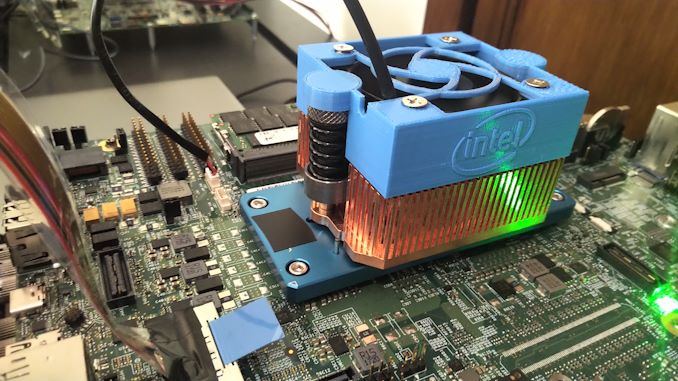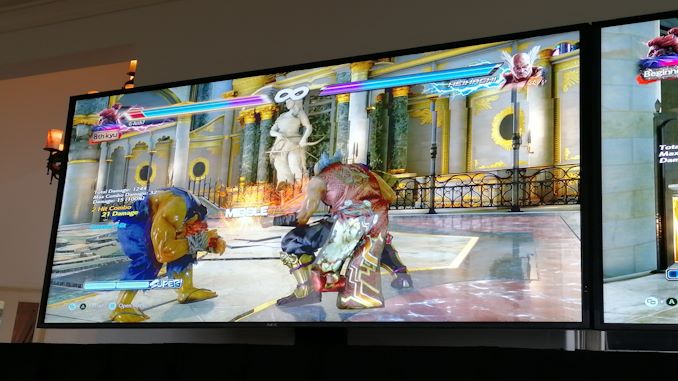Intel's Architecture Day 2018: The Future of Core, Intel GPUs, 10nm, and Hybrid x86
by Dr. Ian Cutress on December 12, 2018 9:00 AM EST- Posted in
- CPUs
- Memory
- Intel
- GPUs
- DRAM
- Architecture
- Microarchitecture
- Xe
Demonstrating Sunny Cove and Gen11 Graphics
As part of the Architecture Event, Intel ran a number of demos on a chip that was supposedly based on the new Sunny Cove cores and Gen11 graphics.
These were development systems with these funky looking heatsinks and loud fans to ensure there was no thermal throttling. One thing worth noticing is that black bit of tape on the heatsink here, which wasn’t present on one of the other demo units.
Hello Ice Lake-U. Being a U-series heatsink, this means that the Core is likely designed for a 15W scenario.
Perhaps it’s no surprise that Intel wasn’t giving anything away in terms of the exact core count on display, speeds, feeds, and power. The demos that were present involved 7-Zip and gaming.
The 7-Zip demo was relatively straight forward, showing how the new instructions such as Vector-AES and SHA-NI in Sunny Cove can give the processor a 75% boost in performance over an equivalent Skylake based platform at iso-frequency. This falls under the ‘specialist’ improvements to the core rather than the general purpose improvements.
The other demo was Tekken 7, being run on a Sunny Cove + Gen11 machine and compared to a Skylake + Gen9 implementation. It looked a good deal smoother that’s for sure, however it was clear that it had some way to go to be fully out of the 30 FPS minimums.














148 Comments
View All Comments
jjj - Wednesday, December 12, 2018 - link
And you acted like someone clueless that has put all his savings in Intel's stock based on brad, "Large revenue stream" LOL, you don't know anything about the product, the target market, about the packaging solution but you get all wet.Anyway, took a look at the slides and they do actually provide some relevant details that yuo seem to not notice. They say face-face, bump pitch at 36um and bump density at 828.mm2.
Spunjji - Thursday, December 13, 2018 - link
Your comments are unnecessarily aggressive, dripping with unwarranted confidence and really unpleasant to read. Please spend more time offline.jjj - Wednesday, December 12, 2018 - link
For the hell of it, I'll add this IMEC slide (different versions out there but this one was the first i could find)http://www.techdesignforums.com/practice/files/201...
iwod - Thursday, December 13, 2018 - link
ignore the trolls.Raqia - Wednesday, December 12, 2018 - link
That's a nice fan on their fanless SoC design. It seems like Intel is really playing catch up with their ultra mobile designs (with a power envelope that's likely still above phones) fabbed on a late 10nm design and only now doing things like heterogeneous cores and PoP memory that the AX and Snapdragons have been doing for a few years now.I wonder what portion of that block diagram's compute reside on the P1222 (which looks bigger die space wise on their diagram than the P1274 but may pack fewer transistors.) They mentioned IO but it wouldn't make too much performance sense for caches and coherency to segregate the Big/Little cores onto separate dies, so it likely contains the ISPs and memory controllers. Where the GPU is located is another interesting question and no LTE modem can be seen on the block diagram. This is also likely to have higher packaging cost and worse integration than the AX, Kirins, PXX's or Snapdragons.
A5 - Wednesday, December 12, 2018 - link
Dev boards have fans because they don't have a chassis to sink heat into. If it's like every other dev board I've used, it is probably a 8k RPM screamer, too.The_Assimilator - Wednesday, December 12, 2018 - link
Seems like you failed to read page 4: "These were development systems with these funky looking heatsinks and loud fans to ensure there was no thermal throttling."Raqia - Wednesday, December 12, 2018 - link
My comment was in reference to their new Atom lineup which are supposed to be fanless, not Sunny Cove which operates in a much higher power envelope. Surely they could use a larger passive cooling unit to demonstrate what's supposed to be a key feature of that product; my other point is that Intel's aiming for something later next year that seems much less advanced than what Apple, Huawei, Mediatek, and Qualcomm already have in production today.The_Assimilator - Thursday, December 13, 2018 - link
And, again, the Fovoros setup was a demo board in the open air, not a production chip inside a device designed around dissipating the heat it outputs.Spunjji - Thursday, December 13, 2018 - link
If that's what you took from that part of the presentation then I feel you missed the point. What Intel are doing in terms of chip layout is something none of the companies you mentioned are able to do yet, which is the fundamental point here - whether it results in a useful product is another matter entirely, but it's still fascinating and not same-same.To back up the other people who responded to you, again, the fan is irrelevant. It's a dev board.